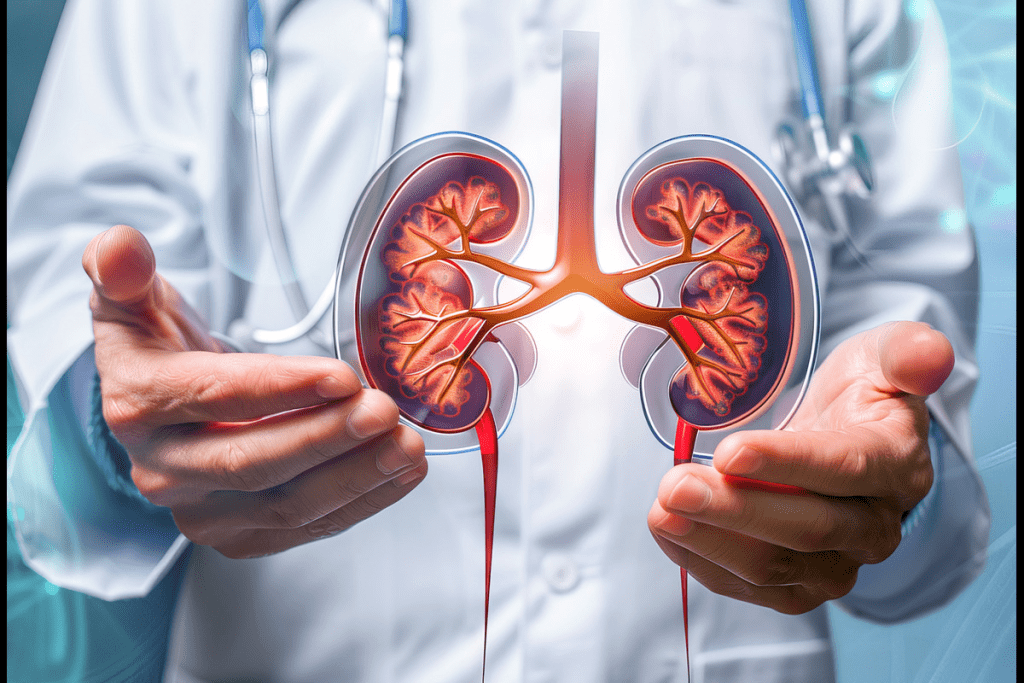Last Updated on November 25, 2025 by
Kidney cancer, also known as renal cell carcinoma, is a serious health issue. Some urologists say about nine out of ten kidney cancers are this type. Early detection is key for effective treatment. Knowing kidney cancer symptoms, such as blood in the urine, back pain, or a lump, can help in recognizing the disease early and improving outcomes.

distorted image’
We will look at the main warning signs for kidney cancer. These include blood in the urine, persistent lower back pain, an abdominal mass, unexplained weight loss, and ongoing fatigue. Spotting these symptoms of kidney cancer early can save lives.
Kidney cancer, also known as renal cell carcinoma, is a big health issue worldwide. It starts in the kidneys, which filter waste from our blood.
We’ll explore what kidney cancer is, its types, and how common it is globally. Knowing this helps us understand who’s at risk and why.
Kidney cancer, or renal cancer, starts in the kidney’s lining. It’s a part of the small tubes that move waste to urine. The most common type is renal cell carcinoma, making up about 90% of cases.
Other types include:
Every year, over 430,000 new cases of kidney cancer are reported worldwide.Statistics show that the average age at diagnosis is 64, and the condition is about twice as common in men as in women. This highlights the importance of awareness and screening, particularly among older adults and men.
Some important facts about kidney cancer are:

distorted image’
Knowing these stats helps us see who’s at risk. It encourages early detection and prevention.
It’s key to spot kidney cancer symptoms early for better treatment and survival chances. Kidney cancer, or renal cancer, often doesn’t show clear signs or symptoms in its early stages. Experts state that kidney cancer is often hard to diagnose, as it doesn’t have clear signs or symptoms in its early stages.
Symptoms of kidney cancer can grow as the tumor gets bigger. More than half of kidney tumors are found by accident during tests for other issues. Yet, up to 30% of patients do show symptoms, which can vary.
The size and location of the tumor affect when symptoms appear. As the tumor grows, it can cause pain, a noticeable mass, or affect nearby areas. Knowing how symptoms start is key for catching it early.

Finding kidney cancer early greatly improves treatment success. Early diagnosis means better treatment options and higher survival rates. Knowing the symptoms and risk factors helps catch it sooner.
People, and those at higher risk, should watch their health closely. Reporting any unusual symptoms to a doctor is vital. Early detection can greatly improve kidney cancer management and treatment.
Blood in the urine is a common sign of kidney cancer. It’s called hematuria. This symptom needs to be checked out further.
Hematuria happens when a tumor grows in or near the kidney. It can invade the renal pelvis or calyces. This invasion can cause bleeding into the urine.
Blood in your urine, which may appear pink, red or cola colored is a symptom that needs more investigation. The blood can be seen or not seen (microscopic hematuria). Either way, it’s important to get it checked by a doctor.
Seeing blood in the urine can be easy if it’s visible. But, sometimes the blood is too small to see. It needs a urinalysis to find.
Blood in the urine is a common symptom of kidney cancer. It happens in about 40“50% of cases. Finding blood in the urine means you should get it checked out.
Spotting kidney cancer early can lead to better treatment results. Knowing the signs, like hematuria, is key.
Persistent lower back or flank pain is a key sign of kidney cancer. It’s important to seek medical help right away. We’ll look at what this pain means, how it’s different from other pains, and its link to kidney cancer.
Flank pain is felt on one side of the body, between the upper abdomen and the back. It’s a sign that can point to kidney cancer. The term “flank” is used to describe the area where the kidneys are. Knowing about flank pain is key for spotting kidney problems, like cancer.
Flank pain from kidney cancer happens when a tumor presses on nearby tissues and organs. This pain doesn’t go away and can’t be eased by changing how you sit or using pain meds.
Long-lasting flank or abdominal pain, along with noticeable lumps, is rare but serious. Pain in your back or side that doesn’t go away might be kidney cancer. This pain means the cancer might have grown, touching other parts or spreading.
It’s critical to recognize the importance of persistent lower back or flank pain for early kidney cancer detection and treatment. While the kidney cancer survival rate depends on when it’s found, noticing and acting on symptoms like flank pain can greatly improve chances.
An abdominal mass or lump can be a big warning sign of kidney cancer. We’ll help you understand this important sign and what it means.
A kidney tumor can grow big enough to feel as a mass in the abdomen. This happens when the tumor gets so big it can be felt under the skin. Cancer Research UK says a lump in your back, under your ribs, or in your neck could mean kidney cancer. It’s key to notice any odd changes in your body.
Not all kidney tumors feel like masses. But when they do, it means the tumor has grown a lot. The presence of an abdominal mass is a big warning sign that needs quick medical help. It’s vital to watch for any changes in your abdomen.
Doing a self-exam can help spot unusual lumps or swellings. Here’s how to do it right:
If you find any odd lumps or have ongoing pain, you must see a healthcare professional. Catching it early is key to good treatment. Being proactive about your health can really help.
Finding an abdominal mass can be scary, but it’s a big step in finding health issues early. By knowing your body and taking action, you can work with your doctor to tackle any worries fast.
Losing weight without a clear reason can be worrying. It might be linked to kidney cancer or other health issues. This symptom can greatly affect a person’s life and health.
Kidney cancer can cause changes in how the body uses energy. Experts note that losing weight without trying can be a sign. These changes affect how the body uses nutrients and energy.
The body’s metabolism can change in many ways with kidney cancer. This includes how hungry we feel and how our body uses energy. Knowing these changes helps find the reason for unexplained weight loss.
It’s hard to tell if weight loss is from kidney cancer or something else. But, cancer-related weight loss often happens without diet or exercise changes. It’s important to watch for any ongoing weight loss and see a doctor if you’re unsure.
When looking at unexplained weight loss, consider overall health and medical history. Also, think about other symptoms. A doctor’s thorough check-up can figure out if weight loss is from kidney cancer or another issue.
Key Points to Consider:
Ongoing fatigue is a big problem for many with kidney cancer. It really hurts their quality of life. Cancer Research UK says many patients feel tired or have no energy. This tiredness is not just from daily tasks but can mean there’s a bigger issue.
Cancer-related fatigue is not like normal tiredness. It’s a deep feeling of exhaustion that doesn’t get better with rest. In kidney cancer, this fatigue can come from the tumor or how the body reacts to it. We know that fighting my RCC (renal cell carcinoma) means we must tackle this fatigue to help patients feel better.
The reasons behind cancer-related fatigue are complex. They involve changes in how the body works, hormonal imbalances, and inflammation. Knowing these details helps us find better ways to manage it.
There are other symptoms kidney cancer patients should watch for. These include:
Keeping an eye on these symptoms is key for catching the disease early. The kidney cancer survival rate goes up when caught early. Spotting these signs early lets patients get help fast.
In short, ongoing fatigue is a big symptom of kidney cancer that affects patients’ lives. By knowing its causes and watching for other signs, patients can act early. This can lead to better treatment and survival chances.
Kidney cancer risk comes from genetics, lifestyle, and environment. Knowing these risks helps prevent and detect cancer early.
Some people face a higher risk of kidney cancer. Older age, smoking, obesity, high blood pressure, long-term dialysis, and family history are key factors. Smoking, for example, harms kidneys and raises the risk of renal cell carcinoma, the main kidney cancer type.
People with genetic conditions like von Hippel-Lindau disease also face higher risks. Knowing these factors helps spot who needs regular check-ups.
While some risks can’t be changed, lifestyle choices can help. Keeping a healthy weight with a balanced diet and exercise is key, as obesity increases risk. Quitting smoking is also vital, as it lowers kidney cancer risk and many other health issues.
Controlling high blood pressure through lifestyle and, if needed, medication is critical. Eating fruits, vegetables, and whole grains, along with regular exercise, boosts health and may lower cancer risk.
By knowing the risks and making smart lifestyle choices, people can lower their kidney cancer risk.
Early detection is key in treating kidney cancer effectively. Recognizing signs like blood in urine, lower back pain, and weight loss is important. This way, people can get medical help quickly.
At livhospital.com, we focus on quality and care in treating kidney cancer. Our team uses the latest methods and puts patients first. Our doctors affirm that the right treatment and team can lead to a positive outcome.
We urge everyone to look after their health. Knowing your risk factors and making healthy choices can help. This way, we can better fight kidney cancer together.
Renal cell carcinoma is the most common kidney cancer. It starts in the lining of the kidney’s small tubes. These tubes help move waste from the blood to urine.
Symptoms include blood in the urine and pain in the lower back or side. You might also notice a lump in your abdomen or lose weight without trying. We cover more symptoms to watch out for.
Doctors use CT scans, MRI, or ultrasound to find kidney cancer. A biopsy then confirms if cancer cells are present. Finding it early is key to treating it well.
Survival rates depend on when the cancer is found. If caught early, the five-year survival rate is much better. We talk about survival rates and why early detection matters.
Yes, making lifestyle changes can lower your risk of kidney cancer. We tell you who’s at higher risk and how to reduce it. This includes lifestyle tips and preventive steps.
Flank pain is on the side of your body, between your ribs and hip. If you have kidney cancer, persistent flank pain is a warning sign. It’s serious if it’s severe or with other symptoms like blood in your urine.
Low potassium isn’t a direct sign of kidney cancer. But, kidney cancer can change your body’s chemistry, affecting potassium levels. Always check with a doctor for the right diagnosis.
Kidney tumors might feel like a lump in your abdomen. We explain how to check yourself and why it’s important. Doctors usually use imaging tests to confirm a tumor.
Creatine is linked to muscle function and is used as a supplement. It’s not directly related to kidney cancer. But, kidney health affects blood levels of substances like creatinine. We discuss how kidney function impacts overall health.
American Cancer Society. (2024). Kidney Cancer”Key Statistics.l
Subscribe to our e-newsletter to stay informed about the latest innovations in the world of health and exclusive offers!